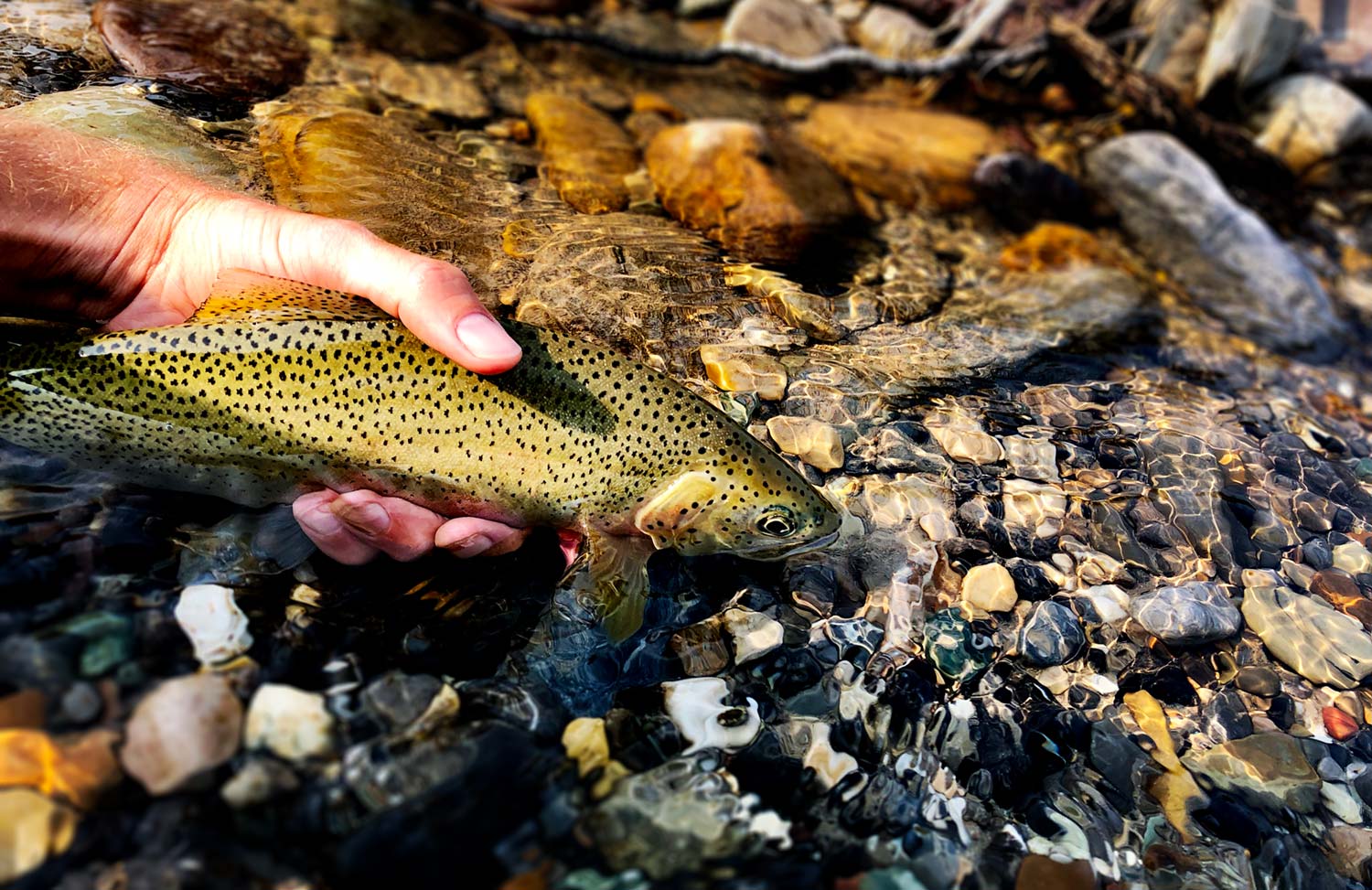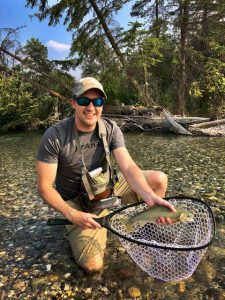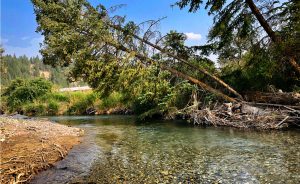
By Jesse Lowry
Late summer out here in the Kootenay’s of British Columbia means hot days and low flows.
Despite the recent heat wave, water temperatures this year managed to stay in safe ranges thanks to a solid snow pack in the alpine. These type of conditions are some of my favourite to be out on the water. It’s still safe for the fish, as the rivers are hanging well below 20c (68f in Murica). The weather’s fantastic, a lot of the rivers are too boney to float, which reduces pressure, makes wading across the entire river a breeze, and you can cover a lot more river on foot as a result.
These western freestone rivers tend to get pretty channelized this time of year, which you would think concentrates the fish into smaller more obvious areas and it does, but that doesn’t necessarily translate into making them easier to catch. Log jams, downed trees, tight deep corners with tricky currents and all sorts of obstacles that make clean drifts a tall order, are where the fish tend to hang out. If you want to catch them you’ve got to put your fly into some sketchy places, and a lot of the time they aren’t coming back out. Losing flies out here is just part of the game, and if you’re not losing them, chances are you’re not fishing some of the best water…. or you’re a Jedi.
I also tend to lose more flies as I do something a little different with my leader/tippet.
 I use lighter tippet than I typically would and I don’t make a smooth transition as I don’t actually want my fly to turn over completely. In these situations I want the tippet to pile when it lands, so I can get that extra foot or two of clean drift which can make the difference in these tight conditions. To achieve this, I tie my tippet to a thicker leader (i.e., 5x tippet to a 3x leader) to create a bit of a hinge point. A bit of curl in the tippet helps as well. Also throwing a size 8 hopper on 5x adds to this tippet pile, as the 5x has trouble transferring enough energy to turn a chunkier fly over. This way when you get to the end of your drift, the piled tippet and your fly can continue to go with the flow for a little bit longer and maybe get you into that pocket deep in the rhubarb where the big guys hang out.
I use lighter tippet than I typically would and I don’t make a smooth transition as I don’t actually want my fly to turn over completely. In these situations I want the tippet to pile when it lands, so I can get that extra foot or two of clean drift which can make the difference in these tight conditions. To achieve this, I tie my tippet to a thicker leader (i.e., 5x tippet to a 3x leader) to create a bit of a hinge point. A bit of curl in the tippet helps as well. Also throwing a size 8 hopper on 5x adds to this tippet pile, as the 5x has trouble transferring enough energy to turn a chunkier fly over. This way when you get to the end of your drift, the piled tippet and your fly can continue to go with the flow for a little bit longer and maybe get you into that pocket deep in the rhubarb where the big guys hang out.
As well, another added benefit with piled tippet is that your fly is much less likely to be moved as you mend your mainline since you will only reduce some of the slack in the pile. (Note: if you start bombing longer casts with this set up you are likely to get some serious tangles). Maybe it’s unnecessary but I’ve had some good success with it and will keep doing it in these situations.
One of the other reasons I love this time of year is it’s a great opportunity to study your water.
 These low flows can reveal some secrets your river generally keeps to herself during higher flows. Boulders, undercuts, log jams, just how deep some of the pools really are, and maybe even some pools you didn’t know were there, all start to reveal themselves. I try my best to make a mental note of this structure as it can help me break things down in higher flows when the river is a little more homogenous. If I know there’s good structure that lurks below, I will allocate a little more time to fishing it more thoroughly. Take the time to change from a dry fly and nymph it out or rip a streamer through. It is all too easy to hole-hop out here with a dry fly and skip over some great fish. (A hopper dropper set up would be great but we are single barbless). Studying your waters at low flows is worth doing even if your temps are too high to fish. A nice stroll through your local river is always a great way to spend a hot afternoon and you can include the non-fishers in your life as well.
These low flows can reveal some secrets your river generally keeps to herself during higher flows. Boulders, undercuts, log jams, just how deep some of the pools really are, and maybe even some pools you didn’t know were there, all start to reveal themselves. I try my best to make a mental note of this structure as it can help me break things down in higher flows when the river is a little more homogenous. If I know there’s good structure that lurks below, I will allocate a little more time to fishing it more thoroughly. Take the time to change from a dry fly and nymph it out or rip a streamer through. It is all too easy to hole-hop out here with a dry fly and skip over some great fish. (A hopper dropper set up would be great but we are single barbless). Studying your waters at low flows is worth doing even if your temps are too high to fish. A nice stroll through your local river is always a great way to spend a hot afternoon and you can include the non-fishers in your life as well.
Good luck out there and enjoy the tail end of the trout season!
Jesse Lowry Gink & Gasoline www.ginkandgasoline.com hookups@ginkandgasoline.com Sign Up For Our Weekly Newsletter!
Three thumbs up! Some interesting and valuable ideas. Rock solid writing. Thank you.
Great read! Lot’s of good information in a tight package. Cheers!